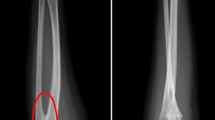Abstract
Three patients are described with 46XX genotype, pseudohermaphroditism, a cloaca, and preserved renal function. Endocrinological causes of the phallic enlargement and labial fusion were absent. The increasing number of reports of this constellation of abnormalities is suggestive of a syndrome where embryogenesis is independent of hormonal status. Masculinisation of the external genitalia appears to be secondary to a fundamental derangement of urogenital development. An early anomaly well before sexual differentiation might prevent the genitalia from acquiring their normal, androgen-dependent growth controls, allowing the genital tubercle and genital folds to develop autonomously.
Similar content being viewed by others
References
Berger GMB, Klempman S (1965) A case of female hermaphroditism with associated congenital defects: review of some aetiologic problems. South Afr Med J 39: 23–26
Broster LR (1956) A form of intersexuality. Br Med J 1: 149–151
Carpentier PJ, Potter EL (1959) Nuclear sex and genital malformation in 48 cases of renal agenesis, with especial reference to non-specific female pseudohermaphroditism. Am J Obst Gyne 78: 235–258
Donahoe PK, Peña A (1986) Abnormalitiesof the female genital tract. In: Welch KJ, Randolph JG, Ravitch MM, O'Neill JA and Rowe MI (eds) Pediatric surgery. Year Book Medical, Chicago, p 1353
Dubovitz V (1962) Virilisation and malformation of a female infant. Lancet II: 405–406
Escobar LF, Weaver DD, Bixler D, Hodes ME, Mitchell M (1987) Urorectal septum malformation sequence. Am J Dis Child 141: 1021–1024
Franks RC, Northcutt R (1963) Female pseudohermaphroditism and renal anomalies. Am J Dis Child 105: 490–496
Gray SW, Skandalakis JE (1972) Embryology for surgeons. Saunders, Philadelphia, p 521
Jost A (1947) Recherches sur la differenciation sexuelle de l'embryon de lapin. III. Role des gonads foetales dans la differenciation sexuelle somatique. Arch Anat Microb Morphol Exp 36: 217–315
Karliw G, Brock W, Rich M, Peña A (1989) Persistent cloaca and phallic urethra. J Urol 142: 1056–1059
Park JI, Johansen A, Jones HW, Blizzard R (1972) Special female hermaphroditism associated with multiple disorders. Obstet Gynecol 39: 100–106
Raffensperger JG (1988) The cloaca in the newborn. In: Stephens FD, Smith ED, Paul NW (eds) Anorectal malformations in children: update 1988. Liss, New York, pp 116–119
Schlegel RJ, Aspillaga MJ, Carneiro-Leao J, Gardner LI (1966) An XX sex chromosome complement in an infant having male-type external genitalia, renal agenesis, and other anomalies. J Pediatr 69: 812–814
Stephens FD (1983) Congenital malformations of the urinary tract. Praeger Publishers, New York, pp 3–14
Templeton JM, O'Neill JA (1986) Anorectal malformations. In: Welch KJ, Randolph JG, Ravitch MM, O'Neill JA and Rowe MI (eds) Pediatric surgery. Year Book Medical, Chicago, pp 1022–1034
Wenstrup RJ, Pagon RA (1985) Female pseudohermaphroditism with anorectal, müllerian duct, and urinary tract malformations. J Pediatr 107: 751–754
Author information
Authors and Affiliations
Rights and permissions
About this article
Cite this article
McMullin, N.D., Hutson, J.M. Female pseudohermaphroditism in children with cloacal anomalies. Pediatr Surg Int 6, 56–59 (1991). https://doi.org/10.1007/BF00174888
Accepted:
Issue Date:
DOI: https://doi.org/10.1007/BF00174888




